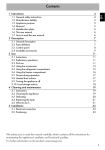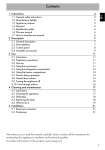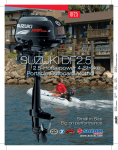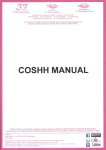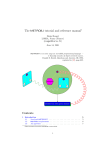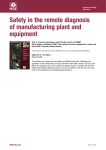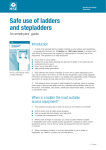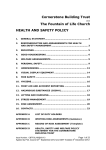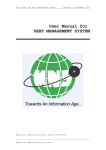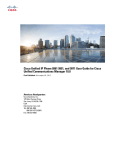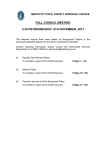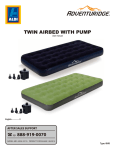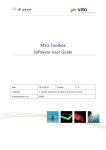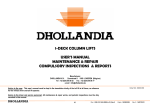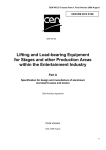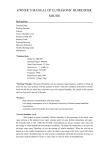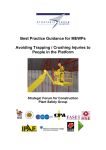Download Hiring and Operation of Inflatable Play Equipment
Transcript
Education Policies and Guidance Previously HSG 2 Hiring and Operation of Inflatable Play Equipment Category: Health & Safety Risk Management and Legal Implications Failure to manage risk may impact on the delivery of Service objectives and the outcomes achieved by Service users. The Education Service aims to mitigate the implications by ongoing management and review of risk in all elements of work activity. The production of this document is one way in which we aim to reduce our exposure to risk. By providing staff with information on good practice, making reference to other guidance that is available across the Council and providing clarity on how we should do things, we can ensure that the management of risk is intrinsic to what we do Version: 01 Last revision: June 2012 Current version at June 2012 Page 2 of 16 Document Title here ______________________________________________________________________________ 1. Purpose 1.1 To ensure a consistent and appropriate approach to hiring, safe use and operation of inflatable play equipment, including bouncy castles in/on all Education Services properties. 1.2 TO ensure compliance with The Management of Health and Safety at Work Regulations 1999. 1.3 To ensure compliance with The Provision and Use of Work Equipment Regulations 1998. 2. Scope 2.1 This procedure is to provide written guidance for Education Service staff involved in the use of inflatable play equipment, including bouncy castles. 2.2 Education Service Staff are expected to refer to this procedure prior to the use of any inflatable play equipment, including bouncy castles, that are not owned in their entirety by Education Service. 2.3 To provide guidance for Education Services staff in the hiring of inflatable play equipment including bouncy castles in/on all Education Services properties. 3 Definitions 3.1 Inflatable Play Equipment Equipment consisting of air-filled structures designed to allow users to bounce, slide or climb on them. They are made from flexible fabric, kept inflated by one or more blowers and rely on air pressure to maintain their shape. Controller – (those who hire to others) The person, organisation or hirer (those who hire to others) having overall control, including responsibility for maintenance of the inflatable play equipment. 3.2 3.3 Operator – (A person over the age of 18 appointed by the controller who is suitably trained in the operation and control of Inflatable Play Equipment including Bouncy Castles) The person who is appointed by the controller to be in charge of the operation of the inflatable play equipment at times when it is in use on Education Services property. Note: Property will relate to buildings and land. 3.4 Hirer – (the person/organisation who has hired the equipment) Any individual, or someone acting on behalf of themselves or an organisation, who is responsible for hiring the inflatable play equipment. 3.5 Attendants – (appointed by the Controller or the Operator or agreed between the Controller, Operator, the Hirer and Management of the premises) Any person over the age of 18 who has been appointed by the Controller or any person over the age of 18 who by agreement has consented to work Current version at June 2012 Page 3 of 16 Document Title here ______________________________________________________________________________ under the control and direction of an Operator to assist in the safe operation of the inflatable play equipment. 3.6 Head of Establishment – (or Nominated Deputy) The person appointed by Education Services who has management responsibility for the establishment at the time of use of the inflatable play equipment. 4. Responsibilities 4.1 Head of Establishment. All Heads of Establishment have the following responsibilities: a) To ensure that all staff are made aware of the requirements of this procedure and adhere to it. b) To ensure staff nominated to carry out the functions detailed in this procedure have received the required training/instruction. c) To ensure adequate resources are made available to allow all nominated staff to operate to this procedure. d) To ensure that an appropriate assessment to the use of inflatable play equipment is carried out and that this is based on a suitable and sufficient Risk Assessment of the activity. e) To ensure that equipment owned or hired complies with the advice given in the HSE publication “Entertainment Sheet No. 7” (Now withdrawn but example of best practice) f) To ensure that operators, hirers and attendants operate in accordance with current best practice. g) To ensure that appropriate action is taken for non-compliance of this procedure. 4.2 Hirer. The hirer is responsible for: a) Notifying the Head of Establishment of the purpose of the hire, to include all equipment/devices that are to be used. b) Ensuring there has been an adequate exchange of information between the Controller, the Head of Establishment, the Operator/Attendant and themselves. c) Evidencing the appropriate documentation from the Controller prior to delivery and erection of the inflatable play equipment. d) Agreeing the Operator/Attendants to be used and their competency. 4.3 Operator/Attendant. The operator/attendant is responsible for: a) The operational control of the inflatable play equipment at any time when it is intended to be available for use to include: I. Users to remove footwear (except socks) and any other hard, sharp or dangerous objects II. Not allow users to consume food, drink or chew gum III. Not allow users to obstruct entrances or exits IV. Not allow users to climb or hang on the walls V. Restrict users to the minimum height stipulations Current version at June 2012 Page 4 of 16 Document Title here ______________________________________________________________________________ VI. VII. VIII. IX. X. Maintain a clear view of the equipment and its entrances and exits Only allow use of the equipment when it is fully inflated Restrict users to any loading regulations that may be in force Restrict users to appropriate age groups In all instances operate the equipment in line with the guidance in the owner/user manual 5. Procedures 5.1 Each Head of Establishment must develop their own Operational System to ensure compliance with this procedure. 5.2 An initial assessment of the Operational needs based on a Risk Assessment of work activities involving the use of inflatable play equipment including bouncy castles must be carried out an the level of supervision identified. Note: A generic risk assessment is attached for information. This must be updated to take account of local operations and practical considerations and reviewed at appropriate times. 5.3 Ensure that all relevant documentation concerning materials, equipment, staffing and usage are checked prior to the use or hire of the equipment. This will include: a) Ensuring the Controller holds public liability insurance with a minimum cover advised by Fife Council Risk Management Service (£2.5 million as at September 2005) Note: Fife Council staff who, having received appropriate training, and are operating and/or supervising the use of such equipment for Council business, will be covered by Fife Council Insurance. Operation of such equipment for reasons outwith Council business will not be covered by Council insurance. b) Possession or evidence of electrical equipment test certificate c) Appropriate supervision by Education Service staff is in place or assurances of Enhanced Disclosure checks if appropriate d) The controller has provided suitable instruction on the safe use of the equipment or has provided a competent person to operate and supervise the use of equipment Note: A further example of best practice is available from the Performance Textiles Association. Information available for download on www.pipa.org.uk Current version at June 2012 Page 5 of 16 Document Title here ______________________________________________________________________________ Checklist for use of Inflatable Play Equipment Date of use ………./…………../……….. Type of equipment …………………………………………………………………….Source of equipment i.e. Self owned or details of controller …………………………………………………………. …………………………………………………………………………………………..…… Date of last inspection of equipment ………/…………./……….. Date of last electrical test ………/…………./……….. Is there adequate public liability cover? Yes No Is the equipment appropriately sited? Yes No Is the equipment secured to prevent movement? Yes No Are correct and adequate electrical supplies in place? Yes No Are supervision measures in place? Yes No Has the proper and adequate training of the supervisor(s), operator(s) and No attendant(s) been carried out? Yes Has the risk assessment on the use of the equipment been undertaken and recorded? Yes No Does the operation of the equipment comply with Education procedure HSG2 – The Hiring, Safe Use and Operation of the Inflatable Play Equipment including Bouncy Castles? Yes No Note: The equipment must not be used if any of the answers are no. The above have been checked and found to be satisfactory. Signature ………………………………………………………………………………….….. Hirer Signature …………………………………………………......................................... Head of Establishment ……………………………………………………………………… Current version at June 2012 Page 6 of 16 Document Title here ______________________________________________________________________________ SAFE USE AND OPERATION OF PLAY INFLATABLES, INCLUDING BOUNCY CASTLES Introduction This information sheet is written to provide guidance for those involved with the design, manufacture, importation, supply, inspection and safe use of play inflatable devices. It lists possible hazards and outlines the precautions that need to be taken to avoid them. It covers inflatables used for bouncing and other purposes but not those used solely for protection. It does not cover waterborne inflatables used in swimmi8ng pools or other types not used by the public for entertainment purposes. The information revises and replaces HSE Guidance Note PM76. It follows the principles in Fairgrounds and Amusement Parks: Guidance on Safe Practice, published by HSE and prepared by the Fairgrounds Joint Advisory Committee (JAC) to improve health and safety standards. (See further reading). Definitions Inflatable Devices Fairground equipment consisting of air-filled structures designed to allow users to bounce, slide or climb on them. They are made up from flexible fabric, kept inflated by one or more blowers and rely on air pressure to maintain their shape. Controller The person, organisation or hirer (those who hire to others) having the overall control, including responsibility for maintenance, or the inflatable device. Operator The person appointed by the Controller to be in charge of the operation of the inflatable at any time when it is intended to be available for public use. Attendant Any person appointed to work under the control and direction of an operator to assist in the operation of the inflatable device. Inspection body An organisation, part of an organisation or individual with the appropriate competence to carry out one or more of the following inspections: Design review; Assessment of conformity to design; Initial test; and, Annual inspection. Inspections Members of the Inflatable Play Manufacturers’ Association (IPMA) and others will be able to carry out 1 in-house design review, assessments of conformity to design and initial tests, if they can meet agreed service quality schedules and procedures for inflatable devices under the Amusement Devices Inspection Procedures Scheme (ADIPS). They will then use common report forms which are similar to those already used for other types of equipment covered by the ADIPS scheme. Current version at June 2012 Page 7 of 16 Document Title here ______________________________________________________________________________ In order to carry out these inspections, including annual inspections, IPMA members and others need to register with the ADIPS scheme as Type B or C inspection bodies (see BSEN 45004 for definitions), under the service quality schedules limited to inflatables. To ensure consistency, this will be backed up by inspections at random intervals carried out by an inspection body registered under ADIPS as Type A, or Type C (which must be independent of inflatables). At these random visits to manufacturers or others, the visiting inspection body will audit the safety-related systems of inspection and see examples of products. Members of the fairgrounds and amusements parks industry association have agreed only to accept reports issued by ADIPS-registered inspection bodies. Nonmembers need to ensure that either inspections are carried out by an ADIPSregistered inspection body or by a competent inspection body which can meet similar standards. In the latter case, the non-member has the responsibility to verify the competence of the inspection body being used. Buying and selling inflatable devices Inflatable devices should not be bought or sold unless the following documentation is available: A report of design review; A report of assessment of conformity to design; and, A report of initial test. These inspections should be carried out by inspection bodies, as explained in the previous paragraph. When the inspections have been satisfactorily completed, the inflatable device will be issued with a Declaration of Operational Compliance (DOC) by the inspecting body issuing the report of the initial test. A DOC will normally be valid for up to one year. The operations manual should contain all the reports referred to in the previous paragraphs, a copy of this information sheet, and all relevant information, including full operating instructions and information on setting up, operating and maintaining the inflatable. It should also contain records of maintenance, details of any modifications, daily checks and annual inspections. Where a device has been manufactured in Great Britain, the duty to provide the preused reports and information referred to earlier falls to the manufacturer. For a second-hand or hired device, the duty falls on the supplier. However, in the case of an imported ride, whether new or second-hand, the duties fall to the supplier. The controller of a newly acquired second-hand device should ensure that the operations manual is present and complete, and arrange for the DOC to be revised in respect of the new owner. Information to be provided by supplier Current version at June 2012 Page 8 of 16 Document Title here ______________________________________________________________________________ For equipment in use before full implementation of this scheme in January 2001, the documentation referred to in the previous paragraphs may not e available. If a DOC or initial test report needs to be completed by a registered inspection body for an inflatable, the sections on design review and assessment of conformity to design should be completed – indicating that the reports will be completed by 1st January 2002 if the inspections have not yet been carried out. Owners or operators of devices will need to carry out risk assessments of their activities to determine the control measures to avoid risk or reduce risk to acceptable levels. This will be relatively easy to do using the manufacturer’s information and instructions for safe operation. This is a requirement of the Management of Health and Safety at Work Regulations 1999. The operations manual should be made readily available. This should not mean that it is kept next to the equipment or that it is written on paper. Computer storage systems may be acceptable for some information, but only if it can be accessed easily and a hard copy produced if required. The following hazards have been known to occur: • • Instability and blowing away in windy conditions; situations caused by loss of pressure as a result of: - failure of the fabric, zips, and seems; - failure or loss of power to the blower; - disconnection of the blower; or, - litter blocking the air intake and/or vents. Falls from the structure - tripping (particularly over anchorages); - injury to users caused by boisterous behaviour, overcrowding or not separating larger users from smaller ones; - access to dangerous (parts of) machinery (e.g. inadequately protected, or unguarded, blower units); - electrical hazards (e.g. shock or burns); - inadequate means of escape in cases of fire; - lifting injuries caused by manual handling; - injury to users caused by wearing inappropriate clothes and shoes; - suffocation; and, - entrapment. Design considerations The designer or manufacturer needs to make sure that: • • • There are no parts of the device or ancillary equipment accessible to users which will cause injury if contact is made with them, e.g. sharp exterior angles or edges; There are no significant trapping points between adjacent surfaces; For bouncy castles especially, the outside walls are high enough, strong enough and attached to the base to prevent users falling out, bouncing Current version at June 2012 Page 9 of 16 Document Title here ______________________________________________________________________________ • • over or slipping through gaps in normal use or foreseeable misuse. As a general rule, the height of users using an inflatable should not exceed the height of the outside walls when the user stands on the bouncing surface. Walls of 1.8 m or higher (measured from the bouncing surface) are sufficient for users of any height. The number and the maximum size of users that the structure can safely contain at any one time is specified in the operations manual; and, The deflation time is sufficient to allow the structure to be safely evacuated – this can be considerably lengthened by using a non-return valve or flap fitted to the blower or by fitting the blow-tube to the lowest part of the structure, as near as possible to the ground. Anchorage Structures should be provided with an adequate anchorage and/or ballast system. The size, number and strength of anchorage point should be adequate for the structure and take account likely wind loading. The designer/manufacturer should carry out research to determine maximum wind speeds and specify the type of anchorage for each inflatable device to be safely used. This information should be kept available. Access/egress On any open side the maximum fall-off height should be no greater that 750mm. Any hard landing surface should be covered by soft landing material such as dense gym mats or equivalent material of at least 25 mm thickness but not more than 125mm, extending for a distance of at least 1.2 m from the open side. Safety mats used indoors should be fire-resistant. When it is necessary to have an anchorage points near to an entrance/exit, they should be connected in such a way as to minimise the danger of tripping, abrasion or other injuries. Blowers These should be suitable guarded at inlet and outlet (IP2X is satisfactory – see BS EN 60529). The inflatable structure should be designed so that the user cannot contact the blower unit. This may be achieved by ensuring the length of any inflation tube is at least 1.2 m when positioned on a walled side and 2.5 m on any open side. Blowers should not be sited internally unless they are in a part of the structure not used for playing and out of possible contact by the user. Special considerations for totally enclosed structures In totally enclosed structures the following additional requirements should be satisfied: • • Signs should indicate exits, meeting the requirements of the Health and Safety (Safety Signs and Signals) rEgulations1996; An independent support system should conform with the requirements of BS 7671; Current version at June 2012 Page 10 of 16 Document Title here ______________________________________________________________________________ • • • • • The electrical installation should conform with the requirements of BS 7671; Structures designed to accommodate more than 15 people should have more than one exit so that the inflatable can be evacuated quickly. Deflation time should be sufficient to allow the structure to be safely evacuated. Emergency lights should be provided as a back-up if a lighting system is installed. The discharge period of the lighting following supply failure should be sufficient to allow for the complete evacuation of the structure. Systems should be fully charged prior to use of the inflatable. Lighting should be proved each day before a totally enclosed inflatable is put into use. Electrical cables should be kept adequately secured away from any users or spectators; Electrical equipment exposed to the weather should be protected to BS EN 60529 or be located inside a weatherproof hut or cabin. Materials Flexible fabrics used in the construction of inflatables need to be of adequate tear and burst strength and have sufficient air retention to enable the structure, when pressurised to the level specified in the operations manual, to maintain its shape and prevent the structure from distorting under load. In particular: • • • • • • Fabric should be flame-resistant (see further reading) and meet current fire safety standards; Adhesives should provide a bond of not less than the equivalent strength to the fabric being bonded; Threads used for sewing should be strong enough for the purpose; Zips should be able to withstand the air pressure generated in the structure. Where they are used for emergency exits they need to be reliable, easy to use and openable from both sides. Netting should not create additional risks to users; and, Toxic decorative finishes should not be used. Inspection, maintenance and modification Once the design is complete, it should be checked by an ADIPS-registered inspection body and a report of design review prepared for the operations manual. A subsequent inspection, known as an assessment of conformity to design, should be carried out by a body registered for that purpose to ensure that the device as built conforms with the original specification which has undergone design review. A report of assessment of conformity to design should be prepared for the operations manual. For repeated manufacture of substantially the same model, this inspection will amount to the manufacturer declaring conformity with the appropriate assessed design. The final inspection to establish initial integrity is an initial test which should be witnessed by a registered inspection body and a report of initial test prepared for the operations manual. Current version at June 2012 Page 11 of 16 Document Title here ______________________________________________________________________________ The Provision of Work Regulations 1998 (PUWER) require inflatable devices to be inspected at suitable intervals to ensure that safe conditions are maintained, and the any deterioration in the device is detected and remedial action taken in good time. (See following paragraphs on annual inspections and daily checks). Annual Inspections Each inflatable should be thoroughly inspected annually or at least once in every 14 months. This procedure needs to be carried out by an ADIPS-registered inspection body, as described earlier. Annual inspection needs to include checks on the following: • • • • • • • • • • • • • • Previous inspection reports and certificates where appropriate; Provision of suitable guards at the air inlet and outlet of the blower; Condition of blower impeller and fan casing; Condition of blower electrical wiring; Condition of all electrical installations; Anchorage system for wear, rips or chafing; Type and number etc of ground anchors or ballast for conformity with design specifications; Structure for wear or rips in the fabric; Walls and towers (when fitted) are firm and upright; Pressure is sufficient in the bouncing area and at the step/front apron to give a reliable and firm footing; Internal ties for wear and tear, particularly at loose or exposed ends; Bed seams, wall-to-bed seams and wall-to-tower connections; Identification of the device; and, If used on a fixed site, the location. Inspections of some of these features may need to be done inside the device. The above list is not exhaustive. Annual inspection needs to include any part of the inflatable and its ancillary equipment which may affect the safe operation of the device. Daily checks Checks should be carried out before the first use on any day using advice provided by the manufacturer in the operations manual. These should include checking that: • • • • • • The site remains suitable, with crowd control measures in place if appropriate; Anchorages are intact, and ropes not worn or chafed; Anchor system secures the inflatable device to the ground; There are no significant holes or rips in the fabric or seams; The correct blower specified for the device is being used and the air pressure is sufficient to give a reliable and firm footing; There are no exposed electrical contacts, there is no wear on electric cables, and plugs, sockets and switches are not damaged; Current version at June 2012 Page 12 of 16 Document Title here ______________________________________________________________________________ • • • • If an internal combustion engine is used, that the fuel cap is placed firmly on the fuel tank and any reserve fuel tank remains in a safe position; Bolts and screws of the blower are properly secured and that robust guards are secured over the air inlet and outlet; The blower/inflation tube connection is in good condition and is firmly fixed to the blower; and, The blower is positioned correctly, adequately protected or guarded and is no causing a tripping hazard. The inflatable should not be used by the public until any defects identified in the daily checks have been rectified. Maintenance The inflatable need to be properly maintained – the instructions contained in the operations manual should be followed. Where such instructions are not available, the controller should specify the procedures required, in conjunction with advice received from an inspection body/manufacturer/supplier. Details of all maintenance work on the device should be recorded in the operations manual. Modification Where a safety critical modification is made (including the replacement of a component which departs from the original design specification), the modification needs to be subjected to a design review before the change is made. The report of design review and the results of any further testing and examination as might be required, i.e. report of assessment of conformity to design and report of initial tests, should be filed in the operations manual. Safety critical modifications are those where failure of the modified component or system would lead to a significant risk of injury to public or employees. They could include changes in the operating parameters of a device, such as changing the height restriction of users. If in doubt, take advice from a competent person. Safe operation It is essential for the safe operation of a device that the manufacturer’s instructions regarding the use of anchorage points should be followed. The device should be secured to the ground with ground stakes, where the ground is suitable. Some equally effective methods can be used on hard standings, e.g. attaching the anchor ropes to fittings already in the ground, or to sandbags or other weights, if these are capable of taking the load. Inflatables can be tied to a vehicle or other movable machinery, providing the vehicle or machinery is immobilised and under the control of the operator. Inflatables should not be used when the wind or gusts are in excess of the maximum safe wind speed specified by the manufacturer. The industry recommends a maximum wind speed of Force 5 on the Beaufort Scale of 30-38 kph (19-24 mph). Force 5 is a fresh breeze when small trees in leaf begin to sway, whereas Force 6 is Current version at June 2012 Page 13 of 16 Document Title here ______________________________________________________________________________ a strong breeze when large branches are in motion, whistling can be heard in telephone lines and umbrellas can only be handled with difficulty. Weather forecasts can be obtained from the Meterological Office. The controller should ensure that the inflatable that the inflatable device is sited well away from possible hazards such as overhead powerlines or other obstacles with hazardous projections (e.g. fences). If the ground surface is abrasive, oily or dirty, a ground sheet should be used to prevent wear and tear to the base material. The controller should determine the minimum number of attendants needed to operate the device safely, and ensure that at least this number of attendants are on duty when the device is in operation. In deciding how many attendants are required, the controller needs to consider matters such as the number of people using the device, the age of the users and the type of environment in which the inflatable is being used. Attendants should be aged 16 or over and the operator should be 18 or over. If the risk assessment carried out by the controller shows that control measures are required to handle large crowds in the immediate vicinity of the inflatable, then crowd control barriers (see figure 1) should be provided by the controller. Barriers should have the minimum dimensions shown at figure 1. They should be at least 1 m high and be capable of withstanding people leaning on them, or being pushed against them. Where the public does not have access to the sides or back of the inflatable or crown pressures are not anticipated, then a lower standard is acceptable. The method of operation drawn up by the controller should ensure that users are admitted to the inflatable in a controlled and safe manner. In particular, the operator and attendant should carry out the following instructions. • Ensure that users remove footwear (except socks) and any other hard, sharp or dangerous objects (such as buckles, pens, purses, badges etc). Glasses are best removed Open side Gateway Figure 1 The perimeter fence should be 1.8-2.5 m from closed sides and 3.5-4.0 m from the open side. The gateway should be 1.0 m wide Current version at June 2012 Page 14 of 16 Document Title here ______________________________________________________________________________ • • • • • • • Do not allow users to consume food or drink or chew gum on the device. Do not allow users to obstruct the entrance or exit of any inflatable device. Do not allow anyone to play or step or from apron of a bouncy castle. Do not allow users to climb or hang on the walls. Do not allow users who do not conform to height restrictions to use the device. Keep the entrance/exit areas clear of onlookers or attendant has a clear view and can ensure that users enter/exit safely. Keep users off the device when it is being inflated or deflated. Deflate the device when not in use. The operator and attendants should watch the activity on the inflatable constantly. They should use a whistle or other signal and take action at the first sign of misbehaviour. Somersaults and rough play should not be allowed. It is the operator’s responsibility to ensure that the equipment is not overloaded with users. Larger, more boisterous users should be separated from the smaller ones. The number of users at any one time should be limited to allow each user enough room to play safely. Training The controller should ensure that all operators receive effective training in the working of the device including: • • • • • • • • The method of operating the device; Safe entry/exit for users; Safe methods of assembly/dismantling, where applicable; How to make a daily check; Safe anchoring of the inflatable; Crowd control measures, and barriers; Measures to be taken in the event of a power failure; and, procedures for reporting accidents, defects or breakdowns. Accident reporting Deal with any casualties first but report the event after the incident. Reportable accidents which cause injury, including acts of violence and certain dangerous occurrences, should be notified to HSE by the ‘responsible person’ (who is likely to be either the controller or operator). Further information is given in the HSE publications A guide to the Reporting of Injuries, Diseases and Dangerous Occurrences Regulations 1995. (see further reading). What to do if defects are found If at any time a defect is found which could possibly lead to danger, the public should not be allowed to use the device until the cause has been identified and remedied. This may include checking all similar components. If there is any doubt about continued safety, the device should not be used until an inspection body has confirmed that it is safe to do so. Keep records of all incidents and significant Current version at June 2012 Page 15 of 16 Document Title here ______________________________________________________________________________ defects in the operations manual and the action taken, because they may be useful if you need to: Give details to HSE, your trade association, insurers, the designer, manufacturer, importer or supplier; Discuss the safety implications with an inspection body; or, Provide a detailed accident history to a buyer. Further reading Fairgrounds and amusement parks: Guidance on safe practice HSG175 HSE Books 1997 ISBN 0 7176 1174 A guide to the Reporting of Injuries, Diseases and Dangerous Occurrences Regulations 1995 L73 (Second Edition) HSE Books 1999 ISBN 0 7176 2431 5 BS EN 45004: 1995 General criteria for the operation of various types of bodies performing inspection BS EN 60204-1: 1992 Safety of machinery. Electrical equipment of machines. Part 1 Specification for general requirements. BS EN 60529: 1992 Specification for degrees of protection provided by enclosures (IP Code) BS 7671: 1992 Requirements for electrical installation. IEE Wiring regulations (Sixteenth edition) For further information of fire-resistant materials refer to BS EN ISO 6940: 1995 BS EN ISO 6941: 1995, and a new British Standard on play inflatables (in preparation) Further information British Standards are available from BSI Customer Services, 389 Chiswick High Road, London W4 4AL Tel: 020 8996 9001 Fax: 020 8996 7001 Website: www.bsiglobal.com HSE priced and free publications are available by mail order form HSE Books, PO Box 1999, Sudbury, Suffolk CO10 2WA Tel: 01797 811 165 Fax 01787 313995 Website: www.hsebooks.co.uk (HSE priced publications are also available from bookshops) For information about health and safety ring HSE’s InfoLine Tel: 08701 545500 Fax: 02920 859260 e-mail: [email protected] or write to HSE Information Services, Caerphilly Business Park, Caerphilly CF83 3GG. You can also visit HSE’s website: www.hse.gov.uk This publication may be freely reproduced, except for advertising, endorsement or commercial purposes. The information is current at 05/01. Please acknowledge the source at HSE Current version at June 2012 Page 16 of 16
















